In most European countries, broadband access services are provided on a national
scale only using wired systems. However, wireless systems have the capability of
addressing broad geographic areas without the costly infrastructure development
required in deploying fixed links to individual sites. Moreover, mobile wireless
systems can extend the wide range of broadband services to users on the move. WiMAX
mobile technology shows particular promise in this regard.
This article – which is extracted from a paper by Bruno Puzzolante, Gianni Redaelli
and Gianni Grazia at CEFRIEL – considers a national WiMAX access network implemented
in Italy using the 802.16e standard. A STEM techno-economic model is developed,
evaluating the most relevant cost drivers, such as data rates and equipment costs,
starting from the services, market penetration and tariffs. Two roll-out scenarios
are examined: a two-step approach in which low-capacity radio equipment is deployed
in the early years before being replaced by higher-capacity equipment; and a single-step
roll-out in which high-capacity equipment is used from the start. A further two
scenarios examine different bandwidth options, using either 5MHz or 10MHz channels
as the basis for the network.
1. WiMAX offers broadband revenue opportunities
Broadband services open up new revenue possibilities for operators. At the same
time, upgrading access networks to support these services requires large investments,
and many alternative technologies can be used. Techno-economic analysis is required
to find out the optimal technologies and systems for different environments.
The IEEE approved the 802.16e standards in February 2004 with the intent of increasing
the use of broadband wireless. Implementations of 802.16e operate at frequencies
below 6GHz (this paper considers implementations using the 3.4–3.6GHz band) and
each channel can have a bandwidth of from 1.25MHz to 20MHz. Further significant
features of 802.16e include: coverage (optimized up to 50km); services (QoS support);
no need for line-of-sight between transmitters and receivers; and mobility support
(users may move at up to about 150km/h). The ongoing evolution of 802.16 will expand
the standard to address mobile applications, thus enabling broadband access directly
to WiMAX-enabled portable devices ranging from smartphones and PDAs to notebooks
and laptops. The high value of such services makes the WiMAX mobile business case
more attractive.
2. Structure of the WiMAX model in STEM
The overall structure of the model is shown below and the main elements are described
in the following section.
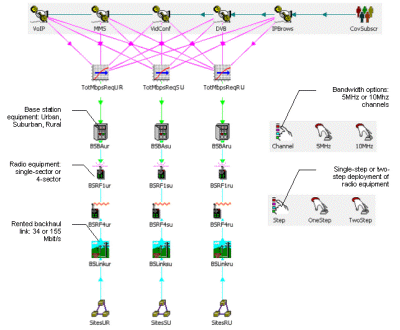
Market Model view of the WiMAX mobile model (Source: CEFRIEL)
Defining the market
The 8000+ Italian municipalities are classified as Urban, Suburban or Rural and
an average population density is calculated as shown in the table below. A Density
Factor is applied which varies from 0.55 in sparsely populated rural areas to 0.14
in suburban areas.

Average population densities of geotypes in Italy (Source: ISTAT, CEFRIEL)
It is assumed that the network reaches 100% population coverage of Urban and Suburban
areas and 80% of Rural within five years. Demand arises in proportion to a penetration
assumption relative to the number of subscribers in covered areas. The traffic demand
of broadband subscribers is expected to grow steadily throughout the period.
Defining the services and calculating traffic demand
Five services are provided: Voice over IP (VoIP),
Video Conferencing (VidConf),
Multimedia Messaging and SMS (MMS), Digital Video
Broadcasting (DVB) and IP Browsing
(IpBrows) – this last includes always-on email and web browsing, on-line
gaming and remote LAN access. Some of these services represent circuit-type traffic,
while others represent data-type traffic. These are modelled differently, as described
briefly below.
Services generating circuit-type traffic
VoIP and Video Conferencing are assumed to be real-time
services, and generate circuit-type traffic that requires dedicated circuits. The
traffic model used is a constant bit rate model, with 100% activity. For all real-time
services, calls are generated according to a Poisson process. In a circuit-type
network, performance measures are based on an “availability service” concept. The
percentage of calls which the network is unable to accept during a particular period
of time (for example an hour), is referred to as a “blockage”. A performance goal
for a voice network could be to guarantee a Grade of Service (probability of blockage)
< 1%. An Erlang B distribution is used to calculate the number of circuits required.
The parameters used by the model for the VoIP and Video Conferencing services are
given below.

Parameters for VoIP and Video Conferencing services (Source: CEFRIEL)
Services generating data-type traffic
The resource demand for data traffic is modelled taking in mind that the data services
are not real-time. Such traffic has been modelled using a packet train as distinct
sessions with a Poisson arrival process. The user initiates a packet call when requesting
an information entity. During a packet call several packets may be generated, which
means that the packet call constitutes of a bursty sequence of packets, as shown
below.
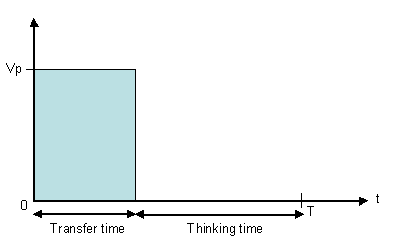
The bursty nature of data-type traffic (Source: CEFRIEL)
It is very important to take this phenomenon into account in the traffic model.
A packet service session contains one or several packet calls depending on the application.
For example in an IP browsing session a packet call corresponds to the downloading
of an IP document. After the whole of the document has arrived at the terminal,
the user takes a certain amount of time to study the information. This time interval
is called reading time (or thinking time). The activity factor can be obtained as:

For the MMS service the Nominal Bandwidth per Connection
has been obtained as:

where the MessagepY is the average number of messages sent by a customer in a year,
and KbytepMMS is the average size of each message. It is assumed that the Contention
Ratio is 1 as provisioning this service is independent of the number of customers
that require it.
A volume-driven calculation can also be utilized, evaluating the Annual to Busy
Hour Unit Ratio as follows:

The parameters used in the model for the MMS service are given below.
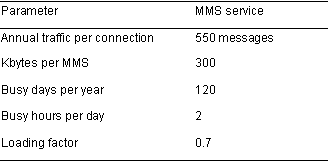
Parameters for the MMS service (Source: CEFRIEL)
For the Digital Video Broadcasting service, the
busy hour traffic calculation is not related to the number of subscribers using
the service. The total Mbit/s required (Busy Hour Traffic) is a function of the
Nominal Bandwidth per Channel and of the number of Channels Reserved.
The parameters used in the model for the Digital Video Broadcasting service are
given below.
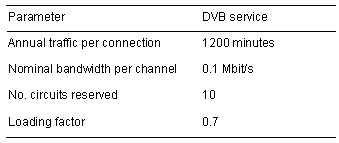
Parameters for the DVB service (Source: CEFRIEL)
IP Browsing is a best-effort service,
and the inputs utilized in this traffic calculation are Nominal Bandwidth per Connection
and Contention Ratio.
The Contention Ratio is calculated as:

where the Mbit/s per Connection Required is defined as:

The Annual to Busy Hour Unit Ratio, to convert the minutes (Annual Traffic Unit)
into Mbit/s (Busy Hour Unit), is obtained as follows:

The parameters used in the model for the IP Browsing service are given below.

Parameters for the IP Browsing service (Source: CEFRIEL)
Options for deployment of equipment
The total traffic generated by all these services is divided between the Urban,
Suburban and Rural segments in proportion to their populations. Each segment has
its own resources and its own deployment strategy. The model evaluates two sets
of deployment options: (a) a single-step versus a two-step roll-out; and (b) 5MHz
versus 10MHz channels.
The cell equipment comprises the basic base station equipment, radio equipment and
a base station link to the backbone network. The radio equipment may consist of
either a single omnidirectional antenna or four sectorised antennas. The physical
lifetime considered is 10 years, with a financial lifetime of 5 years, i.e. the
resources are written off before the end of their physical lifetime. For each base
station, a number of circuits are reserved in order to obtain the Grade of Service
required; this is modelled with a Supply Factor that decreases the available bandwidth.
In the single-step deployment, the base stations are equipped from the beginning
with four sectorised antennas. In the two-step scenario, single omnidirectional
antennas are initially installed, and these are subsequently replaced with four
sectorised antennas when demand exceeds capacity. Replacement of the single-sector
equipment causes decommissioning costs.
The data variants for the two channel scenarios are the unit capacity, the efficiency,
the maximum cell area covered and a flag to determine the type of backbone link
used (34Mbit/s and 155Mbit/s respectively for 5 and 10MHz channels). Cell deployment
is modelled further by the Locations shown in the lowest level of the model view
(see above).
The duplexing method assumed in this model is FDD (Frequency Division Duplexing)
and therefore pairs of frequencies, with the appropriate frequency reuse, have to
be taken into account in planning coverage.
Deployment is driven either by the bandwidth required to meet demand, or by the
geographic coverage required to cover the area. It is assumed that the network reaches
100% population coverage of Urban and Suburban areas and 80% of Rural within five
years. If the number of cells deployed is driven by the geography, there will be
consistent slack capacity. Based on the cell planning of other, previous technologies
it is likely that in the Urban and Suburban segments cell deployment will be driven
by capacity, while in the Rural segment it will be driven by the cell radius.
Assumptions regarding tariffs and costs
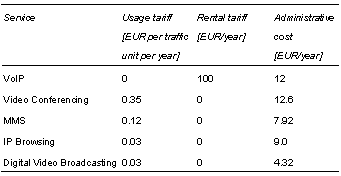
Service tariffs and administrative costs (Source: CEFRIEL)
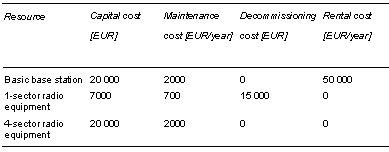
Base station equipment costs (Source: CEFRIEL)
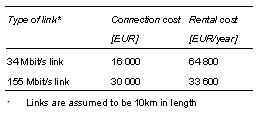
Link rental costs (Source: CEFRIEL)
3. Model results
VoIP is taken as the basic service, and the penetration of other services is expressed
as a proportion of the VoIP penetration.
Scenarios with 5MHz channels
For the 5MHz option, the cell planning takes into account two frequencies per licence
(as required for frequency reuse) and a total spectrum allocation of 20MHz (2 ×
5MHz downlinks plus 2 × 5MHz uplinks). Assuming that there is sufficient available
spectrum to allow two national WiMAX operators, it is assumed that VoIP penetration
has a saturation value of 0.45 in the tenth year (i.e. 45% of the covered population
is served by this operator).
The graph below shows the sites deployed throughout the run period. 9204 cells are
deployed (3215 Urban, 3454 Suburban, 2535 Rural). Assuming four-sector cells, the
average number of users per channel is around 400, corresponding to an efficiency
of about 65% to be applied to the raw channel bit rates.
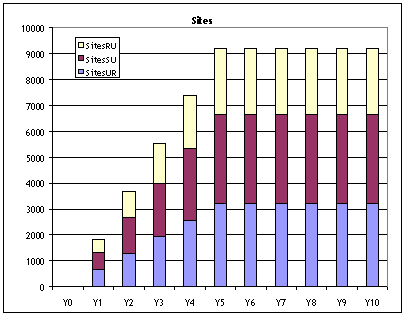
Sites installed (5MHz channels) (Source: CEFRIEL)
Comparing the results between one- and two-step deployment strategies, in both the
5MHz and 10MHz scenarios an upgrade from 1 to 4 sectors is required in the third
year as demand increases above the bandwidth available with one-sector equipment.
However, as the financial results show (see below), in neither case do the decommissioning
costs compensate for the saving obtained with more limited initial investments.
All the results described below refer to the one-step deployment strategy.
Cell deployment is driven by the geography in Rural areas and by the demand for
bandwidth in Urban and Suburban environments: the slack capacity in the final year
is negligible in Urban and Suburban areas, whereas it is not in Rural areas:
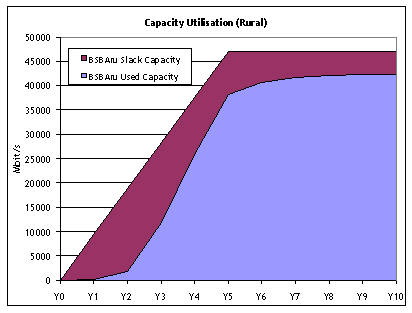
Slack and used capacity for the Rural geotype(5MHz channels) (Source: CEFRIEL)
Scenario with 10MHz channels
As in the 5MHz scenario, the cell planning takes into account two frequencies per
licence, but is based on a spectrum allocation of 40MHz (2 × 10MHz downlinks plus
2 × 10MHz uplinks). Because of the greater need for bandwidth, however, it is possible
that there may not be sufficient spectrum to license more than one national WiMAX
operator. Our analysis considered (a) two players operating under the same boundary
conditions (penetration, services) as in the 5MHz scenario, and (b) a single operator
with a 100% service saturation over its customer base. Deployment in both cases
is driven by the geography rather than demand, for all geotypes. In both cases the
number of sites installed is the same, amounting to a total of about 11 700 by year
five (more than are required for the 5MHz roll-out) – see chart below.
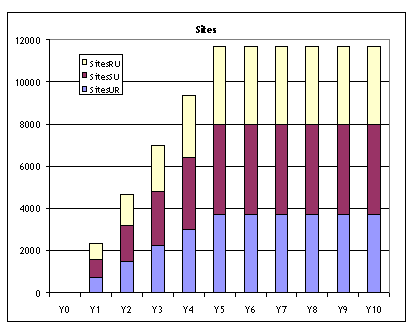
Sites installed (10MHz channels) (Source: CEFRIEL)
If there is more than one player, there will be consistent under-use of capacity,
as described below. The operators would have to consider more efficient uses of
their spectrum, for example to provide better quality services (e.g. Digital Video
Broadcasting with higher quality) or to offer other new types of services. The discussion
below considers the case with two operators.
Assuming a maximum penetration of 45%, an efficiency of about 85% is achieved, with
about 350 users per channel for Urban and Suburban sites, and about 400 users per
channel for Rural sites. The 10MHz channel has a lower impact on the efficiency
due to the higher bandwidth.
The chart below shows the used and slack capacity utilisation for the Rural geotype.
Rural base stations have a utilisation less than 25%, and therefore one-sector antennas
are sufficient to meet demand throughout the model period. For Urban and Suburban
sites, the hardware upgrades are required in the fifth and sixth year respectively.
Here there seems to be more of an economic case for adopting the two-step deployment
strategy, but even so the financial outputs show a negligible percentage difference
in investment.
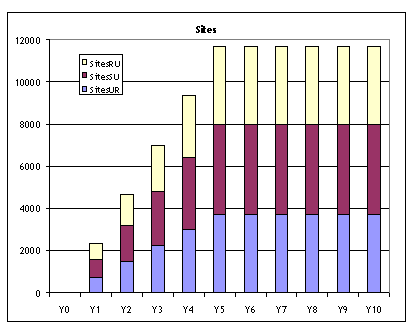
Used and slack capacity for the Rural geotype (10MHz channels) (Source: CEFRIEL)
Financial results
The revenues earned are the same for all the scenarios, as it is only the infrastructure
that is varied, without modifying the take-up of the services or the tariffs. As
can be seen from the graph below, the basic VoIP service generates the greatest
revenue. The lowest income comes from Digital Video Broadcasting and Video Conferencing,
due to the low penetration of these services (30% of VoIP penetration). MMS, with
penetration of 100% of VoIP, makes the second-highest contributions to revenues.
There is slightly less revenue from IP Browsing (70% of VoIP penetration).
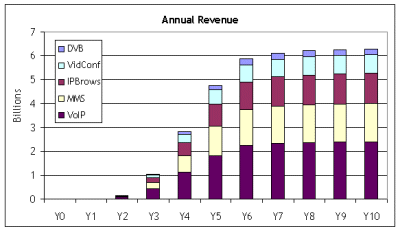
Annual revenue from each of the services (Source: CEFRIEL)
The economic analysis must also take into account the network charge. The graph
below compares the network charge with the revenue for the 5MHz one-step deployment.
As can be seen, profits (revenues minus costs) become positive from the fourth year.
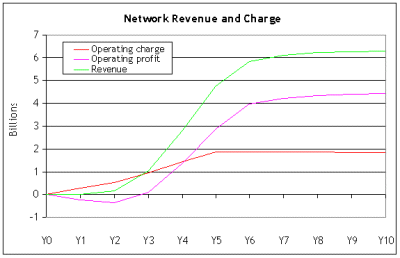
Network revenue and charge (5MHz, One Step variant) (Source: CEFRIEL)
Note: The operating charge is the sum of depreciation and amortisation and operating
costs; operating profit is revenue minus operating charge.
The graph and table below show the Net Present Value for all of the scenarios (with
cash flows assumed to be discounted at a rate of 10%). A positive NPV is observed
from the fourth year in all cases. It can be seen that the differences between the
scenarios are negligible: the revenues are the same, and costs differ only for the
links (34 or 155 Mbit/s) and for the number of steps in the deployment.
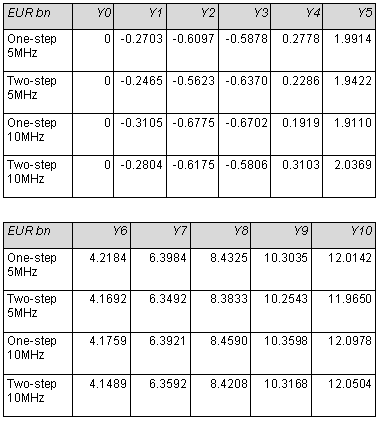
NPV for all four scenarios, assuming 10% discount rate (Source: CEFRIEL)
Comparing the NPVs for the different deployment strategies, for both 5MHz and 10MHz
channelisations the one-step deployment results in a better NPV in the tenth year
(about EUR500 million more than for the two-step approach). Although a two-step
deployment means more limited initial investments, these savings are outweighed
by the additional upgrade costs.
Comparing now the NPVs for the 5MHz and 10MHz scenarios (one-step deployment), the
10MHz scenario results in an NPV about EUR800 million greater in the final year.
This might appear surprising: bearing in mind the greater number of sites required
in the 10MHz roll-out, one would expect this strategy to be more expensive to realize
rather than the 5MHz channelisation. However, the improved NPV can be justified
if one considers the lower rental cost of 155Mbit/s backbone links, and the fact
that all of the Rural sites require only omni-directional antennas.
Another important result for evaluating a business model is the average revenue
per user (ARPU) achieved, which makes it appealing for customers to switch from
their current operator to a new wireless operator. From the model this can be estimated
at about EUR20 per month, which is very competitive when compared with the current
UMTS tariffs proposed for IP-browsing services only.
The CEFRIEL paper concludes that the 5MHz bandwidth variant seems to be more suitable
to provide broadband services to mobile users, although there are wider bandwidths
with higher channel bit rates. The choice can be justified, considering the target
services of a mobile user; broadband services for a portable device are different
in bandwidth usage from fixed-line broadband services. Further analyses can be carried
out comparing the results with a UMTS solution.
CEFRIEL, the Center of Excellence
For Research, Innovation, Education and Industrial Labs partnership in Milan, was
established in 1988 as a partnership between organisations from academia, ICT business
and public administration. CEFRIEL is one of the main centres for technology transfer
in the ICT field, and a leading Italian player in ICT research, innovation and education.